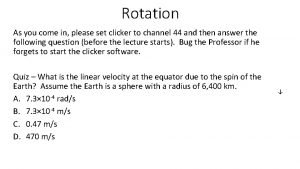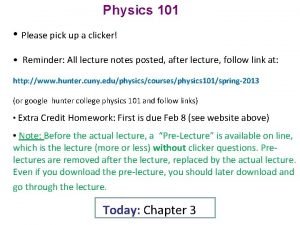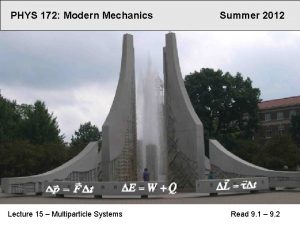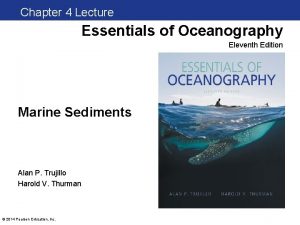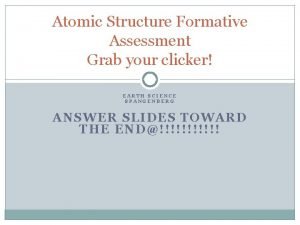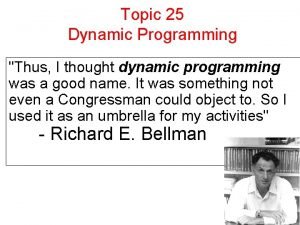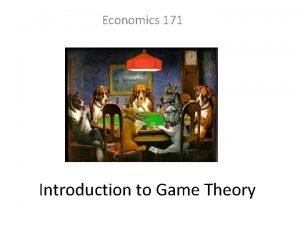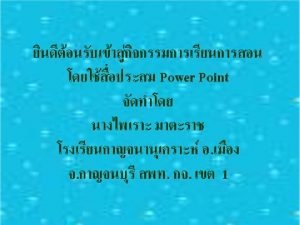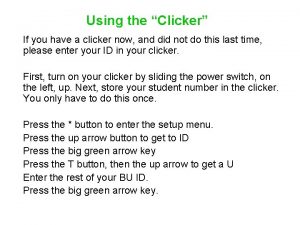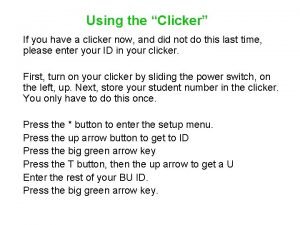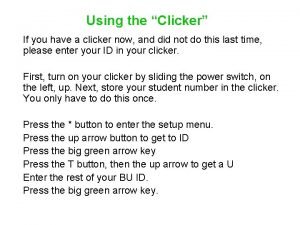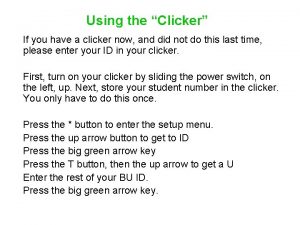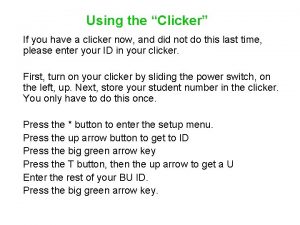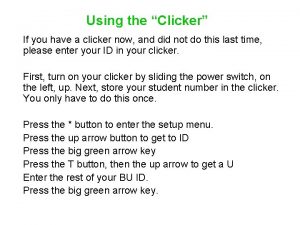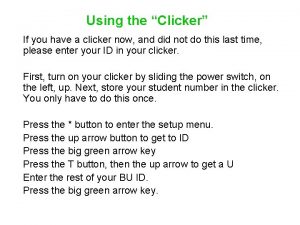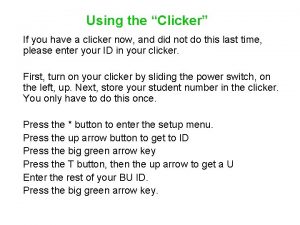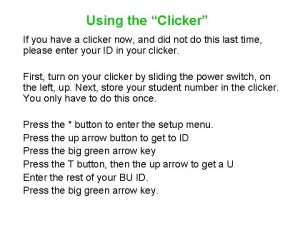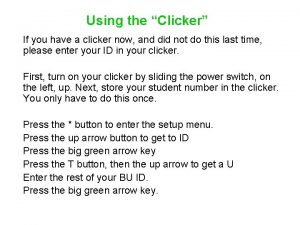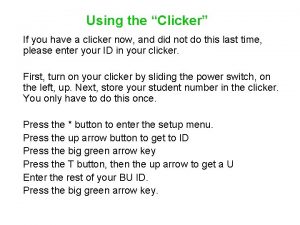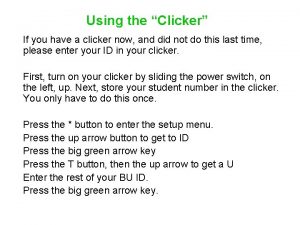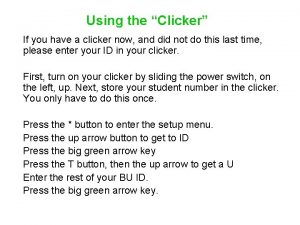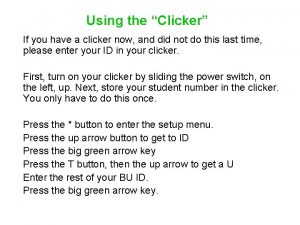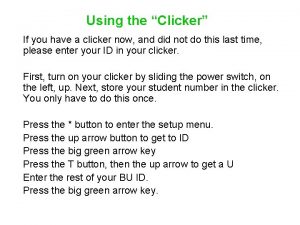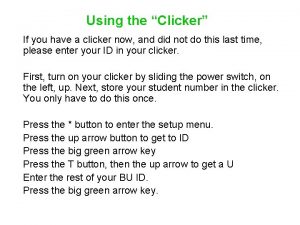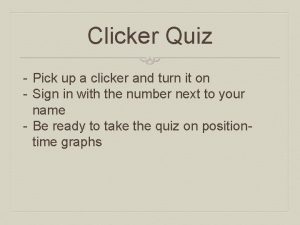Using the Clicker If you have a clicker































- Slides: 31

Using the “Clicker” If you have a clicker now, and did not do this last time, please enter your ID in your clicker. First, turn on your clicker by sliding the power switch, on the left, up. Next, store your student number in the clicker. You only have to do this once. Press the * button to enter the setup menu. Press the up arrow button to get to ID Press the big green arrow key Press the T button, then the up arrow to get a U Enter the rest of your BU ID. Press the big green arrow key.

Uniform circular motion is motion in a circle at constant speed. Is there an acceleration involved here? 1. Yes. 2. No.

Worksheet Let’s figure out what the acceleration depends on. Simulation

The centripetal acceleration For uniform circular motion, the acceleration is directed toward the center of the circle. The magnitude is given by:

Uniform Circular Motion • The path is a circle (radius r, circumference 2 pr). • “Uniform” means constant speed v = 2 pr / T, where the period T is the time to go around the circle once. • Angle in “radians” ≡ (arc length Ds) / (radius r) Dq = Ds 1/r 1 = Ds 2/r 2 is independent of the radius r of the circle, and is dimensionless • Angular velocity w ≡ Dq/Dt = 2 p/T [rad/sec], is also independent of r • Note that v = (2 p/T)r = w r [m/s], and therefore v is proportional to the radius of the circle.

Cut the string A ball is whirled in a horizontal circle on the end of a string. When the string is released, which way does the ball go?

Free-body diagram of the Earth Which free-body diagram of the Earth is correct? Fc stands for centripetal force, Fg for gravitational force.

My personal opinion Don’t use the term “centripetal force” because that makes you think a magical new force pops up whenever something goes in a circle. We don’t need any new forces! The ones we already know about are sufficient.

A general method for solving circular motion problems Follow the method force problems! • Draw a diagram of the situation. • Draw one or more free-body diagrams showing all the forces acting on the object(s). • Choose a coordinate system. It is often most convenient to align one of your coordinate axes with the direction of the acceleration. • Break the forces up into their x and y components. • Apply Newton's Second Law in (usually) both directions. The key difference: use

Disks on a turntable Two identical disks are placed on a flat turntable that is initially at rest. One disk is closer to the center than the other disk is. There is some friction between the disks and the turntable. We start spinning the turntable, steadily increasing the speed. Which disk starts sliding on the turntable first? 1. The disk closer to the center. 2. The disk farther from the center. 3. Neither, both disks start to slide at the same time.

Disks on a turntable (see the worksheet) Sketch a free-body diagram for one of the disks, assuming it is not sliding on the turntable. Apply Newton’s Second Law, once for each direction.

Disks on a turntable Sketch a free-body diagram (side view) for one of the coins, assuming it is not sliding on the turntable. FN FS Axis of rotation mg Can you tell whether the velocity is into or out of the screen?

Disks on a turntable – force equations y-direction: x-direction:

Disks on a turntable – force equations y-direction: x-direction:

Disks on a turntable – force equations y-direction: x-direction:

Disks on a turntable – force equations y-direction: x-direction:

Disks on a turntable – force equations y-direction: x-direction:

Disks on a turntable – force equations y-direction: x-direction:

Disks on a turntable – force equations y-direction: x-direction: As you increase r, what happens to the force of friction needed to keep the disk from sliding?

Coins on a turntable (work together) Apply Newton’s Second Law, once for each direction. y-direction: FN - mg = 0 so that FN = mg x-direction: FS = max = m(v 2/r) [both FS and a are to left] FN y x Axis of rotation FS mg As you increase r, what happens to the force of friction needed to keep the coin on the circular path? Can you tell whether the velocity is into or out of the screen? * * It is the same diagram and result either way!

“Trick” question! v has a “hidden” dependence on r, so that the “obvious” dependence on r is not the whole story. The two coins have different speeds. Use angular velocity for the comparison, because the two coins rotate through the same angle in a particular time interval. This gives: As you increase r, what happens to the force of friction needed to keep the coin staying on the circular path?

“Trick” question! v has a “hidden” dependence on r, so that the “obvious” dependence on r is not the whole story. The two coins have different speeds. Use angular velocity for the comparison, because the two coins rotate through the same angle in a particular time interval. This gives: As you increase r, what happens to the force of friction needed to keep the coin staying on the circular path? The larger r is, the larger the force of static friction has to be. The outer one hits the limit first. Simulation

Conical pendulum A ball is whirled in a horizontal circle by means of a string. In addition to the force of gravity and the tension, which of the following forces should appear on the ball’s free-body diagram? 1. 2. 3. 4. 5. 6. A normal force, directed vertically up. A centripetal force, toward the center of the circle. A centripetal force, away from the center of the circle. Both 1 and 2. Both 1 and 3. None of the above.

Conical pendulum (see the worksheet) Sketch a free-body diagram for the ball. Apply Newton’s Second Law, once for each direction.

Conical pendulum (work together) Sketch a free-body diagram for the ball. Tsinq q Axis of rotation T q y Tcosq x mg Resolve Choose Apply Newton’s Second Law, once for each direction. x-direction: T sinq = m(v 2/r) y-direction: T cosq = mg Solve:

Gravitron (or The Rotor) In a particular carnival ride, riders are pressed against the vertical wall of a rotating ride, and then the floor is removed. Which force acting on each rider is directed toward the center of the circle? 1. 2. 3. 4. 5. A normal force. A force of gravity. A force of static friction. A force of kinetic friction. None of the above.

Gravitron (see the worksheet) Gravitron simulation Sketch a free-body diagram for the rider. Apply Newton’s Second Law, once for each direction.

Gravitron (work together) Sketch a free-body diagram for the rider. He’s blurry because he is going so fast! FS Axis of rotation FN mg y x Apply Newton’s Second Law, once for each direction. y direction: FS - mg = may = 0 (he hopes) x direction: FN = max = m (v 2/r)

Acceleration of the Earth r = 150 million km = 1. 5 × 1011 m T = 1 year ≈ π × 107 s The acceleration is:

Uniform Circular Motion • The path is a circle (radius r, circumference 2 pr). • “Uniform” means constant speed v = 2 pr / T, where the period T is the time to go around the circle once. • Angle in “radians” ≡ (arc length Ds) / (radius r) Dq = Ds 1/r 1 = Ds 2/r 2 is independent of the radius r of the circle, and is dimensionless • Angular velocity w ≡ Dq/Dt = 2 p/T [rad/sec], is also independent of r • Note that v = (2 p/T)r = w r [m/s], and therefore v is proportional to the radius of the circle.

Whiteboard
 Samuel they have rejected me
Samuel they have rejected me 6 faces
6 faces Math clicker
Math clicker E clicker
E clicker Turning point audience response
Turning point audience response Lesson 5 building an app clicker game
Lesson 5 building an app clicker game Earth clicker
Earth clicker Maximal heart rate
Maximal heart rate Hitler clicker
Hitler clicker Clicker stop motion
Clicker stop motion Cooi clicker
Cooi clicker Umbc clicker
Umbc clicker Clicker box
Clicker box Roger rabbit
Roger rabbit Clicker stop motion
Clicker stop motion Clicker
Clicker Phys 172
Phys 172 Buzka clicker
Buzka clicker Salt clicker
Salt clicker Clicker gravel transport
Clicker gravel transport Atomic clicker
Atomic clicker Touch the spacebar
Touch the spacebar Dynamic problem
Dynamic problem Clicker
Clicker Presentation clicker challenger
Presentation clicker challenger Cos clicker
Cos clicker Atomic clicker
Atomic clicker Evolutionary history
Evolutionary history Clicker questions physics
Clicker questions physics If you had studied hard you would have succeeded
If you had studied hard you would have succeeded Do you have to cite when you summarize
Do you have to cite when you summarize You must unlearn what you have learned
You must unlearn what you have learned











